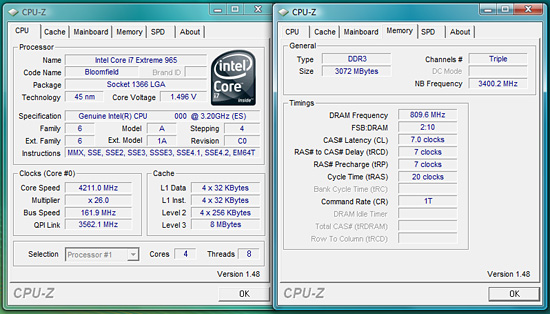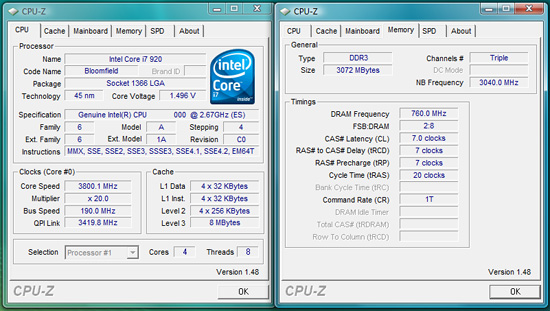The Dark Knight: Intel's Core i7
by Anand Lal Shimpi & Gary Key on November 3, 2008 12:00 AM EST- Posted in
- CPUs
Overclocking: The Initial Results
Our first overclock test with the top Core i7 processor, the 965XE, suggests an average high-end air or water-cooled, 24/7 stable overclock of about 4.2GHz (roughly the same as the latest Yorkfield-based, quad-core processors available right now). Our VCore setting had to increase to 1.5V for stable operation, a significant jump from the 1.4125V required at 4GHz on this board. We set QPI/Dram to 1.325V and VDimm to 1.65V. Our top clock with this particular CPU on our FreeZone Elite cooler is 4.5GHz with 1.55V.
Our second overclock test utilized the 920 processor that clocks in at a stock 2.66GHz. The multiplier is locked on this CPU and the 940 model so overclocking is done via Bclk. We were able to reach a 24/7 stable 3.8GHz overclock on 1.5V with memory (BIOS 0503 raised our voltage requirements) at DDR3-1520 (7-7-7-20) on 1.675V. We think 4GHz is possible on this board with additional tuning and a BIOS update. However, Bclk is limited to around 200~220 on the current i7 series, so additional headroom is probably limited on this CPU. However, performance was excellent during overclocking and a 3.6GHz overclock was possible with 1.425V. This CPU reminds us of the Q6600 at launch, an excellent overclocker that continues to be a bargain.
Although the new architecture allows for near-independent tuning of the processor cores and the underlying memory subsystem, mastering your system will still require a fair amount of patience and consideration. There are numerous tuning tradeoffs with this platform that we are still working through at this time. One such trade off is determining whether to use high CPU multipliers and standard memory ratios when overclocking versus a lower CPU multiplier and high Bclck (bus speed) combination.
In early testing, we have found advantages to both methods depending on the application. It appears right now that a combination of higher Bclk with a lower CPU multiplier will provide a slightly better performing platform, if you can properly balance the memory timings, voltages, and speed. We will help direct your efforts in this process by providing a complete overclocking guide for Core i7 shortly.












73 Comments
View All Comments
Kaleid - Monday, November 3, 2008 - link
http://www.guru3d.com/news/intel-core-i7-multigpu-...">http://www.guru3d.com/news/intel-core-i...and-cros...bill3 - Monday, November 3, 2008 - link
Umm, seems the guru3d gains are probably explained by them using a dual core core2dou versus quad core i7...Quad core's run multi-gpu quiet a bit better I believe.tynopik - Monday, November 3, 2008 - link
what about those multi-threading tests you used to run with 20 tabs open in firefox while running av scan while compressing some files while converting something else while etc etc?this might be more important for daily performance than the standard desktop benchmarks
D3SI - Monday, November 3, 2008 - link
So the low end i7s are OC'able?
what the hell is toms hardware talking about lol
conquerist - Monday, November 3, 2008 - link
Concerning x264, Nehalem-specific improvements are coming as soon as the developers are free from their NDA.See http://x264dev.multimedia.cx/?p=40">http://x264dev.multimedia.cx/?p=40.
Spectator - Monday, November 3, 2008 - link
can they do some CUDA optimizations?. im guessing that video hardware has more processors than quad core intel :PIf all this i7 is new news and does stuff xx faster with 4 core's. how does 100+ core video hardware compare?.
Yes im messing but giant Intel want $1k for best i7 cpu. when likes of nvid make bigger transistor count silicon using a lesser process and others manufacture rest of vid card for $400-500 ?
Where is the Value for money in that. Chukkle.
gramboh - Monday, November 3, 2008 - link
The x264 team has specifically said they will not be working on CUDA development as it is too time intensive to basically start over from scratch in a more complex development environment.npp - Monday, November 3, 2008 - link
CUDA Optimizations? I bet you don't understand completely what you're talking about. You can't just optimize a piece of software for CUDA, you MUST write it from scratch for CUDA. That's the reason why you don't see too much software for nVidia GPUs, even though the CUDA concept was introduced at least two years ago. You have the BadaBOOM stuff, but it's far for mature, and the reason is that writing a sensible application for CUDA isn't exactly an easy task. Take your time to look at how it works and you'll understand why.You can't compare the 100+ cores of your typical GPU with a quad core directly, they are fundamentaly different in nature, with your GPU "cores" being rather limited in functionality. GPGPU is a nice hype, but you simply can't offload everything on a GPU.
As a side note, top-notch hardware always carries price premium, and Intel has had this tradition with high-end CPUs for quite a while now. There are plenty of people who need absolutely the fastest harware around and won't hesitate paying it.
Spectator - Monday, November 3, 2008 - link
Some of us want more info.A) How does the integrated Thermal sensor work with -50+c temps.
B) Can you Circumvent the 130W max load sensor
C) what are all those connection points on the top of the processor for?.
lol. Where do i put the 2B pencil to. to join that sht up so i dont have to worry about multiply settings or temp sensors or wattage sensors.
Hey dont shoot the messenger. but those top side chip contacts seem very curious and obviously must serve a purpose :P
Spectator - Monday, November 3, 2008 - link
Wait NO. i have thought about it..The contacts on top side could be for programming the chips default settings.
You know it makes sence.Perhaps its adjustable sram style, rather than burning connections.
yes some technical peeps can look at that. but still I want the fame for suggesting it first. lmao.
Have fun. but that does seem logical to build in some scope for alteration. alot easier to manufacture 1 solid item then mod your stock to suit market when you feel its neccessary.
Spectator.